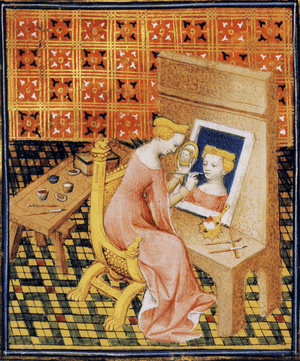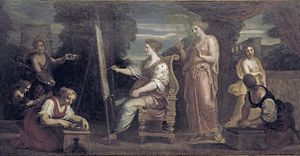Iaia facts for kids
Iaia of Cyzicus, sometimes (incorrectly) called Lala or Lalla, was a Roman painter, alive during the time of Marcus Terentius Varro (116–27 BC).
Contents
Life
Born in Cyzicus, she was a famous painter and ivory engraver. Iaia likely came to Rome to meet the demand for art there in the late Republic. Most of her paintings are said to be of women. Pliny attributes to her a large panel painting of an old woman and a self-portrait. She was said to have worked faster and painted better than her male competitors, Sopolis and Dionysius, which enabled her to earn more than them. Iaia remained unmarried all her life.
Influence on culture
Literature
Iaia is one of the five female artists of antiquity mentioned in Pliny the Elder's Natural History (XL.147–148): the others are Timarete, Irene, Aristarete, and Olympias. Iaia is one of three women artists mentioned in Boccaccio's De mulieribus claris. The character of Julie Lambert, protagonist of the novel "Shining harmony" (2017), and of the poetic anthology "Living and not living" (2018), both by Italian writer Sabrina Gatti, was inspired by Iaia di Cizico. In the novel, Julie, a talented painter, sees in Iaia the artist to emulate, and dedicates to her a painting where she portrays the Roman painter, intent on painting in her atelier; while in "Living and not living", the young woman is completely identified with Iaia.
Art
Iaia (as Lalla) is one of the names featured on Judy Chicago's Heritage Floor.
See also
 In Spanish: Iaia de Cícico para niños
In Spanish: Iaia de Cícico para niños



